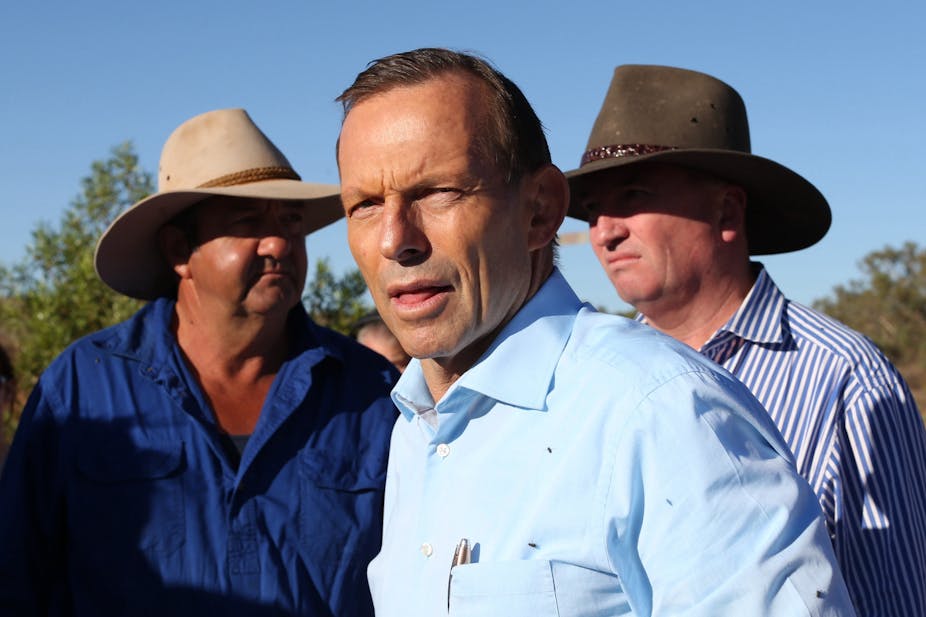Whoever is advising Prime Minister Tony Abbott understands something of the place of the larrikin in the Australian national consciousness.
Abbott’s threat to shirtfront Russian President Vladimir Putin channels the imagery of the plucky and muscular Australian hero to demonstrate his mettle on both the domestic and international stages.
The iconography of the larrikin is an inextricable part of the Australian tradition of masculinity. It connotes a rare combination of egalitarianism, irreverence, resilience and loyalty.
This vision harks back to the Aussie spirit of the “the diggers” – Australia’s heroes, legends and mates. These men built the nation and fought on the battlefields in far-away lands to protect the Australian way of life and the “fair go”.
Even the less heroic elements of the larrikin are part of the Australian construction of masculinity. These elements include brawling, drinking, womanising and fighting, which Professor Manning Clark discusses in his opus, A History of Australia.
The term “larrikin” is one of endearment. Peccadilloes and misdemeanours are forgiven and indeed embraced. Despite former prime minister Bob Hawke’s admission of excessive drinking and womanising, he had the highest popularity rating of any prime minister since the introduction of public opinion polls.
According to a recent survey, 60% of Australians think it would be a bad thing if our larrikin nature disappears.
Yet, while embodying ideals of egalitarianism, nationhood and a collective identity, the social cohesion associated with the larrikin ideal has not extended outside a selected group. As Melissa Bellanta shows in her book, Larrikins: A History, historically larrikinism was homophobic, racist and misogynistic.
In their recent book, The Australian Leadership Paradox, Geoff Aigner and Liz Skelton dig into Australian history to explain the culture of leadership and the paradox of mateship. Mateship is a sentiment that while inclusive also excludes.
While mateship and survival have been linked in Australian history, the legacy of exclusion continues. An ascendant patriarchy of white Anglo-Saxon men remains a feature of Australian institutions, partly explaining the lack of women in leadership roles.
Australia has the lowest rates of female company directorships in the world. Forty of our top 200 public companies have no female directors. The number of female chief executives remains at around 3% and women make up around 8% of senior managers. The gender pay gap is increasing and now stands at 18.3%. In the current federal cabinet there is only one woman and 18 men.
It is also largely men who are recognised when the Order of Australia awards are announced. This may explain why Australia’s foray with a female prime minister was doomed to fail. Given the lack of history and the absence of other criteria, many voters view a female political leader through the prism of sexual stereotypes.
According to a recent survey, one in four Australians believe that men make better politicians than women. The World Economic Forum Global Gender Gap report says Australia’s position relative to the rest of the western developed world has deteriorated year on year in terms of economic participation and political equality. In 2014, Australia ranks 51st out of 124 countries in terms of female economic participation. Since 2006, Australia has slipped nearly ten spots in the annual ranking.
Feminist writer Eva Cox attributes Australia’s poor stance on gender equity to a static culture that negates legal initiatives.
The regeneration and popularisation of the Anzac ideals over the last 15 years, while commemorating the sacrifices made by Australian heroes, institutionalises into the national memory an association between heroics and masculinity. In turn, this reinforces the alignment between masculinity and leadership.
Perhaps it is not by chance that military men are being appointed as heads of state – former general Peter Cosgrove as governor-general, former general David Hurley as governor of NSW, and former rear admiral Kevin Scarce as governor of South Australia. In times of threat both real and imagined, masculine leadership is sought to allay the anxiety of the times.
It is concerning that cold war antics are on the rise. What is needed is mature visionary leadership that transcends the binary antics of “them and us”.
The recent G20 committed to reduce the gender participation rate gap by 25% by 2025. It is yet another step that recognises the benefits of a balanced gender composition at the leadership level within government and corporations.

